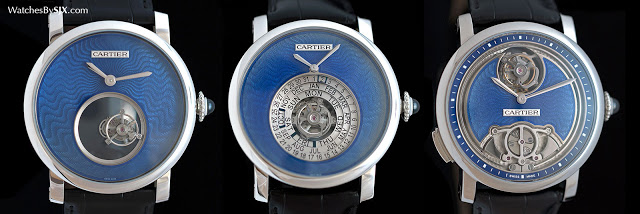Introducing the Million Dollar Cartier Grand Complication Box Set in Blue Enamel (with Original Photos)
A three-piece box set of Cartier's most complicated wristwatches - Astrocalendar, Mysterious Double Tourbillon and minute repeater - the Grand Complication Box is distinguished by its brilliant blue enamel dials.
Cartier combines two skills it has mastered in the Grand Complication Set: high horology watchmaking and enamelling. The three-piece set is made up of the most unusual and complex timepieces Cartier has introduced in recent years, comprising the Astrocalendar, Mysterious Double Tourbillon and Minute Repeater Flying Tourbillon. All three are presented in the Rotonde de Cartier case, and fitted with dials decorated with rich blue flinqué enamel.
All three watches are powered by movements hallmarked with the Poinçon de Genève, a seal of quality administered by the government of Geneva. This means the movements meet functional and decorative standards, as well as having been assembled in Geneva, where Cartier recently opened a workshop on the rue du Rhône.
The dials, on the other hand, are made at the La Maison des Metier d’Art in La Chaux-de-Fonds, a two hour drive from Geneva. Located in a restored 19th century farmhouse, “the house of artisanal crafts” brings the various decorative arts for watchmaking under one roof. The repertoire includes enamelling, including the flinque technique found on the Grand Complication Set (and also the Ballon Bleu 39 Flying Tourbillon introduced last year).
Each dial starts out as a disc of 18k white gold that is then engraved with a moiré guilloche, a wavy, repeating pattern radiating from the centre of the dial. Enamel is then painted onto the dial, layer by layer, and then fired in an oven. Essentially coloured, powdered glass mixed with water or oil, the enamel is melted and fused to the gold base. The result is a glossy, vividly coloured blue dial with a richness and brilliance that cannot be achieved with synthetic lacquer.
| The dark spots on the enamel are tiny bubbles characteristic of fired enamel; a lack of bubbles indicates synthetic enamel |
Though all three watches in the set are large, all have the same 45mm diameter, the blue enamel dial makes it seem smaller than the regular versions with conventional silver and grey dials. While the trio in box set share the same dial decoration, each is equipped with a different complication.
Rotonde de Cartier Double Mysterious Tourbillon
The Double Mysterious Tourbillon gets its name from the fact that there is no visible connection between the tourbillon and the rest of the movement. It also rotates on two axes – the tourbillon cage rotates on itself every minute, while the cage complete a circle around the sapphire window every five minutes.
Like other Cartier mystery timepieces, the tourbillon is driven by a sapphire disc with teeth on its rim. Those teeth mesh with the gear train of the movement, providing the power to drive the tourbillon on its two axes.
The Double Mysterious Tourbillon is 45mm in diameter and in platinum.
Rotonde de Cartier Astrocalendar
Also 45mm in diameter and in platinum is the Astrocalendar, one of the most unique perpetual calendars on the market. The Astrocalendar features an “amphitheatre” display, with the calendar on stepped, concentric rings around a flying tourbillon. Blue brackets travel around the calendar rings to indicate the date, month and day of the week.
The construction of the calendar is also notable. It is entirely gear based, lacking the springs found in most calendar mechanisms. Though that means the calendar indications gradually slide forward rather than jump simultaneously at midnight, it means the calendar is far more robust and convenient to set. The Astrocalendar can be set at any time, backwards or forwards, without damaging the movement. Our earlier story on the Astrocalendar explains it in greater detail.
Rotonde de Cartier Minute Repeater Flying Tourbillon
The third and most complicated watch in the set is also the most visually appealing, with the two part blue enamel dial framing the exposed minute repeater mechanism. The Rotonde de Cartier Minute Repeater Flying Tourbillon was Cartier’s most complex wristwatch when it was launched, but it was recently superseded by the Rotonde de Cartier Grand Complccation Skeleton.
| The flying tourbillon at 12 o’clock |
Despite losing its crown, the minute repeater still remains an impressive timepiece, with a movement made up of some 447 parts. The 9402 MC movement was the first in-house minute repeater from Cartier, developed with a rigorous, scientific approach to create the best chimes. The result is a repeater that chimes at 68 decibels, louder than the volume of normal conversation. From the back, the striking mechanism for the repeater is revealed, with the numerous racks, snails and gears visible.
Unlike the two other watches in the box set, the minute repeater has a titanium case in order to achieve the loudest and most resonant sound. The density of precious metals hinders sound transmission, while the stiffness and lightness of titanium improves it.
Sold only as a trio, the Grand Complication Set is presented in a lacquered mahogany box. Only five sets will be made. The retail price is available upon request, but it slightly more than buying each watch separately. That puts the set in the ballpark of S$1 million or US$750,000.
Back to top.